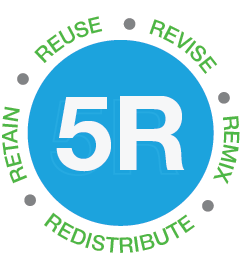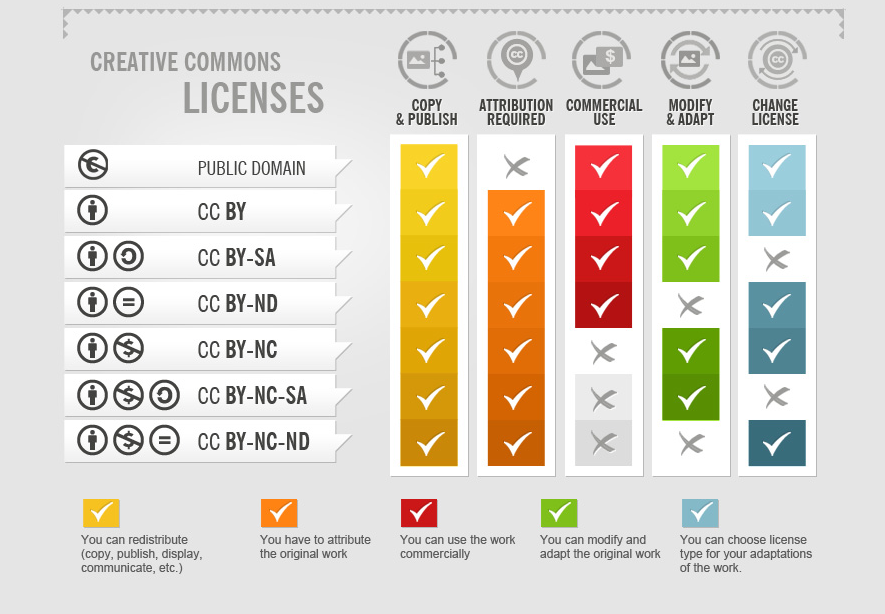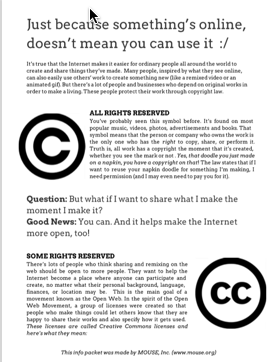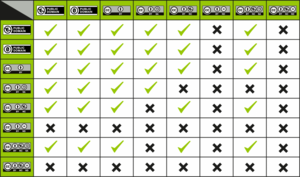For Instructors

Materials created by David Wiley, CC by 4.0
An open license is one which grants permission to access, re-use and redistribute a work with few or no restrictions. These types of licenses, like Creative Commons, are generally developed under the 5Rs to allow users to do the following:
- Retain – the right to make, own, and control copies of the content (e.g., download, duplicate, store, and manage)
- Reuse – the right to use the content in a wide range of ways (e.g., in a class, in a study group, on a website, in a video)
- Revise – the right to adapt, adjust, modify, or alter the content itself (e.g., translate the content into another language)
- Remix – the right to combine the original or revised content with other material to create something new (e.g., incorporate the content into a mashup)
- Redistribute – the right to share copies of the original content, your revisions, or your remixes with others (e.g., give a copy of the content to a friend)
Essentially, open licenses allow for content to be used, modified and built upon.
The type of permissions given to a user of the openly licensed item, depends on the creator and the license they have assigned to their work. The benefit of open licenses are they allow the creator to select the permissions and restrictions according to how they would like their content used.
Types of Open Licenses
To work in an open environment, it’s important to assign your work an open license like the Creative Commons License. The open license allows you to a provide ways that potential users of your resource can use and attribute your material.
To assign a creative commons license to your own work, follow this workflow.
When reviewing your work, you need to consider the following:
- Are all elements of the resource original creations? If yes, do I want to share all the information openly?
- Have I used content (e.g. images, videos, etc.) from other sources? If yes, do I have the right to modify the item to use for my own pupose?
- Is the content I’m using openly licensed? If yes, what does the license allow me to do with the item?
If you are uncertain of the content you have used to develop your resource, contact the Scholarly Communications & Copyright Office.
To select a license that best represents how you would like your work used and attributed, review the following resources:
- UBC Copyright – Creative Commons License Terms
- UBC Copyright – Understanding the Different Creative Commons Licenses
- Considerations for Licensors and Licensees
There is a simple Creative Commons tool for generating an HTML, XMP, and Offline (graphic) license. Once you have selected your license, use the following:
Open Licenses and Student Work
|
When adopting a resource, you need to be aware of how the resource can be used. This will require you to look for rights and permissions.
Rights and permissions outline how work can be used, including produced, copied, performed, published, adapted, translated or telecommunicated. It’s important to remember that just because an item is available online, it does not give an individual the right to use the work however they choose.
The following is an example of finding permissions for a YouTube video.
Review Video for Infringement
Before using the video, you need to review the content for potential infringement.
- As noted by the Copyright Office guidelines on Using Videos in the Classroom,
- You are free to display online streaming videos (including Youtube videos) in the classroom, provided that the videos meet the requirements listed above, and that you also satisfy the following criteria:
- you do not break or circumvent a Digital Lock to access or obtain a copy of the work;
- there is no clear and visible notice on the website or on the work itself that prohibits the use or reproduction of the work (more than just a copyright symbol);
- the website is not questionable, infringing or clearly using the works without the copyright owner’s consent ; and
- you identify the source of the work and, if available and applicable, the author, performer, maker or broadcaster of the work.
- This means if the content is infringing on copyright (e.g. A YouTube user has uploaded the movie, “The Conjuring”) you cannot display that video.
- If you cannot find the “Terms of Use” or “License” for an item, contact the Scholarly Communications and Copyright Office for assistance.
Additional Examples of Identifying Permissions
Creative Commons License Permissions
Although Creative Commons Licenses support the open use of resources, creators can assign a license that allows only specific kinds of uses. For example, a creator can assign a license that allows others to modify and adapt the original work, but under the requirement that the new resource provides attribution to the original and is shared with the open community.
To best understand Creative Commons License permissions, find the license assigned to the original work and use the following table to identify how the CC licensed work can be used and under what conditions.

All Creative Commons licenses require that users of the work attribute the creator. When providing attribution to a CC-licensed work, you should include:

- the author’s name, screen name, or user ID, etc. If the work is being published on the Internet, it is best practice to link that name to the person’s profile page, if such a page exists.
- the work’s title or name (if applicable), if such a thing exists. If the work is being published on the Internet, it is best practice to link the name or title directly to the original work.
- the specific type of license the work is available under. Linking to the license will allow others to find the license terms
- The URL where the work is hosted
- Mention if the work is a derivative work or adaptation, in addition to the above, one needs to identify that their work is a derivative work i.e., “This is a Finnish translation of [original work] by Rie Namba.” or “Screenplay based on [original work] by Rie Namba.”
For in-depth examples on citing Creative Commons images, please see the Creative Commons Image Citation Guide from the UBC Copyright Site.
Resources
Looking for more information on proper ways to attribute Creative Commons licensed recourses? Check out these in-depth guides:
- How do I properly attribute a CC licensed work?: FAQ from Creative Commons
- Creative Commons best practices for attribution A set of examples of incorrect, good, and better attributions
- Attributing Creative Commons Materials A 9-page guide from Creative Commons Australia on best practices for attribution of Creative Commons licensed materials.
- How to attribute Creative Commons licensed materials for Teachers and Students: a 7-page guide for Teachers and students from Creative Commons Australia on how to attribute Creative Commons materials.
For Students
Did you know that undergraduate students at UBC “retain copyright in all works created during their course of study. Graduate students retain copyright in their own works (including theses) unless a research contract in support of the student’s work dictates otherwise” (excerpt from: Student FAQs – Copyright at UBC). This means that you can apply an open license to your work if you want to share it so that others can build on it. You may also choose to use or build on the work of others. Learn how to license your own work and find, adapt and attribute work created by others.
Just because something is online, doesn’t mean you can use it :/

While the internet makes it easy to create and share your own work and be inspired by the work of others, some people make their living from original works. Copyright law allows them to protect their work.
On the other hand, there are others who like to create, share and remix on the open web. To let others know that their work is available for re-use (in the way that they specify), open licenses were created (called Creative Commons Licenses).
Mouse.org has produced an excellent introduction to the open web and an overview of CC licenses (we have borrowed the title above). They include a handy chart to let you know exactly what you can and can’t do according to the terms of the various Creative Commons licenses. They also include a beginning reference list for locating openly licensed content (such as music and images).
Basically, a Creative Commons license is useful if you want to let people know that your original work is open for others to share or build on as long as they attribute you as the original author.
What else do I need to know?
Creative Commons provides a license chooser to help you select a license based on your preferences.
Now that you have selected a license, you’ll want to apply it to your work. Creative Commons can help with that too, by showing you how to apply your license in a variety of formats.
Creating and publishing to YouTube? You can also select a CC license for any video you upload to YouTube. This will allow others to find and build on your work or access it for remixing using YouTube’s video editor.
- More about CC licenses on YouTube.
- Adjusting licensing and permissions on YouTube – how-to with screen shots from Jorum.
- Finding & Using Creative Commons Media – UBC – a curated list of sources for openly licensed resources, images, music, video, etc. which you can embed – with attribution- in any resource you create.
- Free Music Archive
- Archive.org
- Wikimedia Commons
Choose two works you wish to combine or remix. Find the license of the first work on the first row and the license on the first column. You can combine the works if there is a check mark in the cell where the row and column intersect. Use at least the most restrictive licensing of the two (use the license most to right or down state) for the new work. If there a cross at the intersection of the row and column then you can not just these works. This probably indicates that one of the two licenses may not used for commercial purposes, or one of the licenses does not allow for derivative works to be created. Creative Commons – Wiki/cc license compatibility .

by Creative Commons, CC by 4.0
Using CC licensed work requires you to attribute (or acknowledge) the original author of the photos, videos and other open resources you may use in the course of your learning. Here are examples of good (and not so good) practices for attribution:
- Creative Commons website overview of the licenses: http://creativecommons.org/licenses/
- Creative Commons license chooser that adds helpful metadata for those attributing you, if you add the code generated to your webpage(s), blog, etc.: http://creativecommons.org/choose/
- Student FAQ : Student’s FAQ on copyright.
- UBC Copyright guide to Creative Commons, including where/how to search for CC-licensed content
- Video: Creating OER and combining licenses: learn how to license a new work (remix) you create from someone else’s original.





